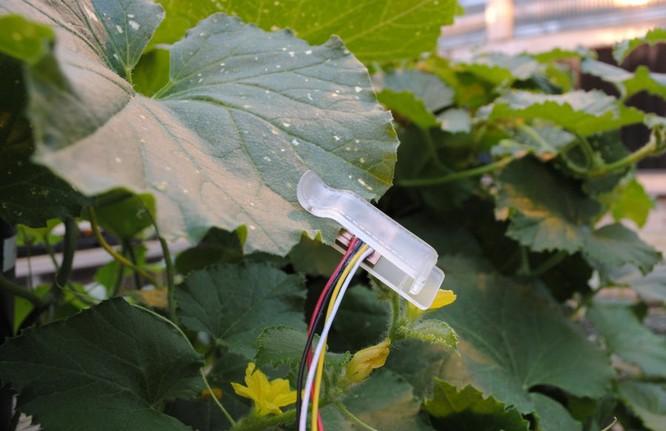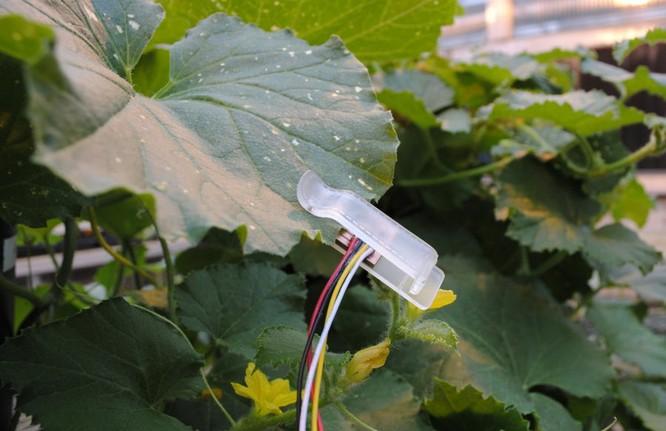
Credit: Penn State
Plant-based sensors that measure the thickness and electrical capacitance of leaves show great promise for telling farmers when to activate their irrigation systems, preventing both water waste and parched plants, according to researchers in Penn State's College of Agricultural Sciences.
Continuously monitoring plant "water stress" is particularly critical in arid regions and traditionally has been done by measuring soil moisture content or developing evapotranspiration models that calculate the sum of ground surface evaporation and plant transpiration. But potential exists to increase water-use efficiency with new technology that more accurately detects when plants need to be watered.
For this study, recently published in Transactions of the American Society of Agricultural and Biological Engineers, lead researcher Amin Afzal, a doctoral degree candidate in plant science, integrated into a leaf sensor the capability to simultaneously measure leaf thickness and leaf electrical capacitance, which has never been done before.
The work was done on a tomato plant in a growth chamber with a constant temperature and 12-hour on/off photoperiod for 11 days. The growth medium was a peat potting mixture, with water content measured by a soil-moisture sensor. The soil water content was maintained at a relatively high level for the first three days and allowed to dehydrate thereafter, over a period of eight days.
The researchers randomly chose six leaves that were exposed directly to light sources and mounted leaf sensors on them, avoiding the main veins and the edges. They recorded measurements at five-minute intervals.
The daily leaf-thickness variations were minor, with no significant day-to-day changes when soil moisture contents ranged from high to wilting point. Leaf-thickness changes were, however, more noticeable at soil-moisture levels below the wilting point, until leaf thickness stabilized during the final two days of the experiment, when moisture content reached 5 percent.
The electrical capacitance, which shows the ability of a leaf to store a charge, stayed roughly constant at a minimum value during dark periods and increased rapidly during light periods, implying that electrical capacitance was a reflection of photosynthetic activity. The daily electrical-capacitance variations decreased when soil moisture was below the wilting point and completely ceased below the soil volumetric water content of 11 percent, suggesting that the effect of water stress on electrical capacitance was observed through its impact on photosynthesis.
"Leaf thickness is like a balloon — it swells by hydration and shrinks by water stress, or dehydration," Afzal said. "The mechanism behind the relationship between leaf electrical capacitance and water status is complex. Simply put, the leaf electrical capacitance changes in response to variation in plant water status and ambient light. So, the analysis of leaf thickness and capacitance variations indicate plant water status — well-watered versus stressed."
The study is the latest in a line of research Afzal hopes will end in the development of a system in which leaf clip sensors will send precise information about plant moisture to a central unit in a field, which then communicates in real time with an irrigation system to water the crop. He envisions an arrangement in which the sensors, central unit and irrigation system all will communicate without wires, and the sensors can be powered wirelessly with batteries or solar cells.
"Ultimately, all of the details can be managed by a smart phone app," said Afzal, who studied electronics and computer programming at Isfahan University of Technology in Iran, where he earned a bachelor's degree in agricultural machinery engineering. He is testing his working concept in the field at Penn State.
Two years ago, he led a team that won first place in the College of Agricultural Sciences' Ag Springboard contest, an entrepreneurial business-plan competition, and was awarded $7,500 to help develop the concept.
Growing up in Iran, Afzal knows water availability determines the fate of agriculture. In the last decade, the Zayandeh River in his home city of Isfahani has dried up, and many farmers no longer can plant their usual crops. "Water is a big issue in our country," said Afzal. "That is a big motivation for my research."
Afzal's technology is very promising, noted Sjoerd Duiker, associate professor of soil management, Afzal's adviser and a member of the research team. Current methods to determine irrigation are crude, while Afzal's sensors work directly with the plant tissue.
"I believe these sensors could improve water-use efficiency considerably," Duiker added. "Water scarcity is already a huge geopolitical issue, with agriculture responsible for about 70 percent of world freshwater use. Improvements in water use efficiency will be essential."
In a follow-up study, Afzal has just finished evaluating leaf sensors on tomato plants in a greenhouse. The results confirmed the outcomes of the just-published study. In his new research, he is developing an algorithm to translate the leaf thickness and capacitance variations to meaningful information about plant water status.
###
Also participating in the research were Jack Watson, professor of crop and soil science, and Dawn Luthe, professor of plant stress biology.
The U.S. Department of Agriculture's National Institute of Food and Agriculture supported this work.
Media Contact
A'ndrea Elyse Messer
[email protected]
814-865-9481
@penn_state
http://live.psu.edu





